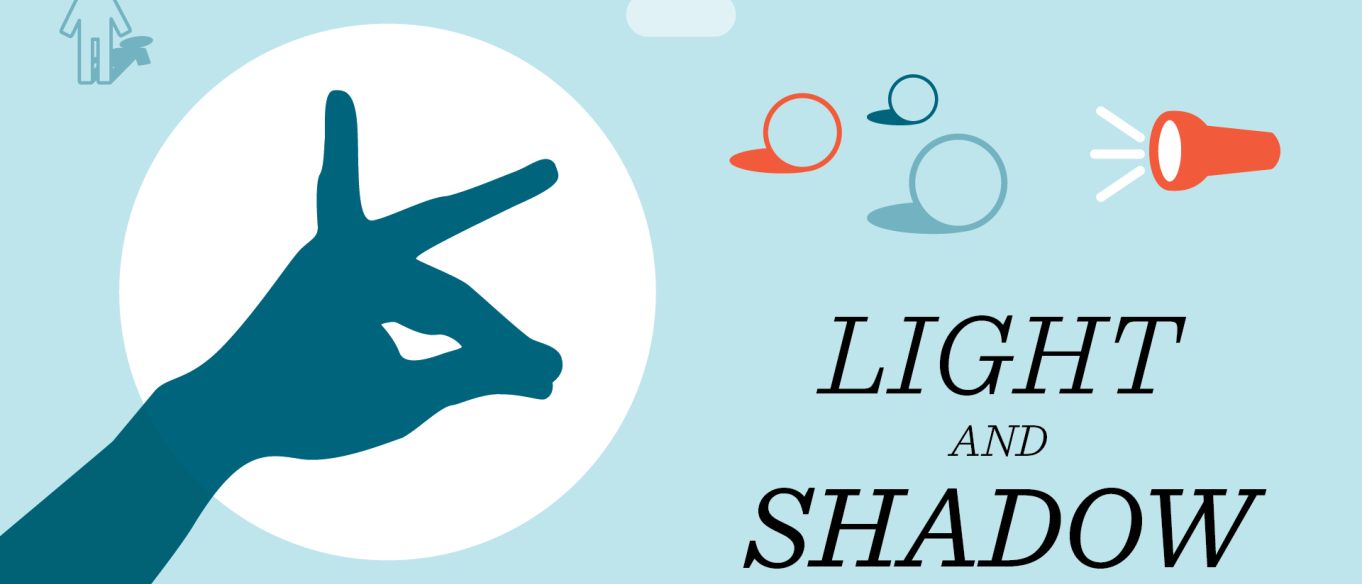
If you’ve ever watched your own shadow, you’ve probably noticed that sometimes it’s shaped a lot like you—but sometimes it looks very different! What makes shadows change shape so often? In this activity, you’ll experiment with using everyday objects to create surprising shadows.
Age: 6+
Time: 20 - 40 minutes
Topics: light, shadow, STEAM
What you need:
- A flashlight
- Different objects to help you create shadows, like:
- Blocks
- Paper clips
- Cotton balls
- Buttons
- Shapes cut from paper or cardboard
- Dry erase board or white sheet of paper
- Dry erase marker or regular marker
- A partner (optional)
What to do:
1. Start with some research about shadows by going on a shadow hunt! Look around the room for as many different shadows as you can find. Pay close attention to what object is making each shadow that you see and where the light is coming from to create the shadow. Here are some questions to think about as you go on the shadow hunt:
- What do you notice about the color, size, and shape of the shadow?
- Why do some shadows look darker or bigger than others?
- Is more than one light source helping to create the shadow? How can you tell?
2. Now it’s time to make your own shadows. Find a blank surface like a wall in a darker corner of the room where you can make clear shadows. You might want to turn off other lights or pull down the window shades to make the room darker. Test your flashlight by shining it on the surface to make sure the light is strong enough to create shadows.
3. Experiment with making shadows using the objects you gathered. What do you notice about the shadows you’re making? How can you make the shadow bigger and smaller, or darker and lighter?
4. See how many different shadow shapes you can make using the same object. Here are some questions to think and talk about as you explore:
- What happens to the shadow when you move the flashlight from one side to the other?
- What happens if you move the flashlight higher or lower?
- How does the shadow change as you turn the object in different directions?
5. Next, put your research into action with a shadow challenge: Using the materials you gathered, put them together to create a shadow that looks like it belongs to a different object. For example, you could arrange cotton balls and paper clips together to make a shadow shaped like a tree.
6. Use the flashlight to test your shadow often while you work. Remember, if it doesn't work the way you planned at first, keep trying! Scientists often have to test, tweak, and try again (and again!) to find the best solution.
7. If you have a partner to work with, try this challenge: Put a white piece of paper or dry erase board against the surface where your shadow is and trace the outline of your shadow on the paper or board. Then take apart the structure that made the shadow, leaving the outline.
8. First, see if your partner can guess what shape the shadow outline is (a tree, a spaceship, a monkey). Next, give them the objects you used to make the shadow. Challenge them to recreate the structure you made and make a shadow that matches the outline.
9. Now switch roles: have your partner make a unique shadow shape for you to recreate!
10. Other ideas to try:
- Use the same set of objects to make as many different shadow shapes as you can. Could you create a monkey shadow and a car shadow from the same objects?
- Make two structures that create the same shadow shape, but are made of completely different objects.
- Try to create a shadow shape using objects that don't touch each other. How can you arrange the objects so they work together to make a shadow shape without touching?
What’s happening?
When an object blocks light from shining on a surface, it creates a shadow. A shadow is simply an area where less light is shining on a surface because another object is absorbing or reflecting away some of the light. When you put your hand in front of a flashlight, your hand absorbs or reflects all the light that hits it, preventing that light from reaching the wall behind it. As you move your hand closer to the flashlight or change the position of your fingers, different areas of the light are blocked, which changes the visible shape of the shadow.

